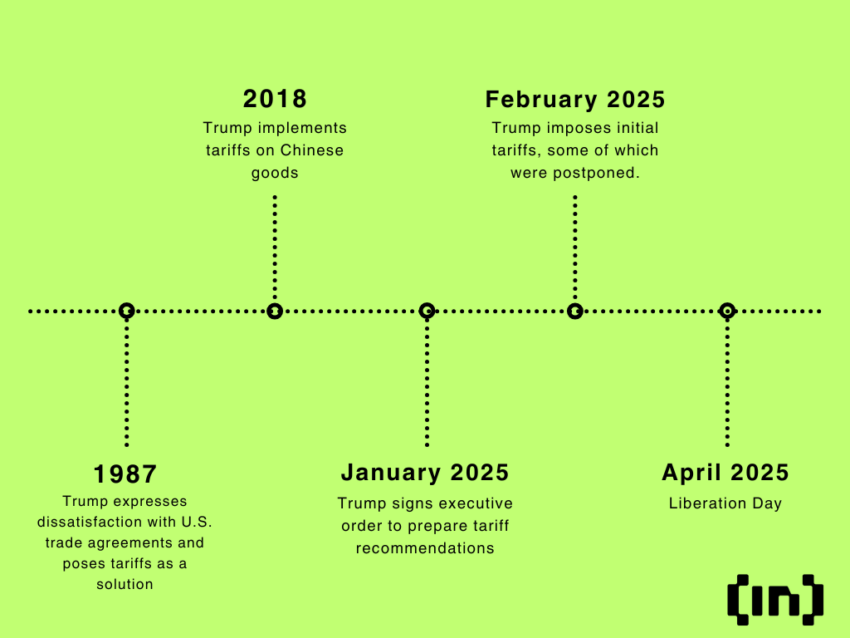-
As President Trump’s “Liberation Day” approaches, its potential impact on the cryptocurrency markets cannot be overlooked amid rising tariffs and inflation concerns.
-
Recent analysis indicates that, while short-term turmoil may affect digital assets, the long-term potential for Bitcoin and other cryptocurrencies as alternative investments might increase.
-
“Tariffs raise the cost of trade, which can lead to inflationary pressures that impact risk assets like cryptocurrencies,” notes financial analyst Arthur Hayes.
President Trump’s upcoming “Liberation Day” tariffs on April 2 may drive crypto market volatility, sparking short-term pain but offering long-term potential for digital assets.
The Significance of Trump’s “Liberation Day” for Crypto Markets
On April 2, 2025, President Donald Trump plans to enact significant import tariffs, referred to as “Liberation Day.” This move is emblematic of his ongoing trade policies aimed at renegotiating global trade agreements. The proposed tariffs could heighten tension in international markets, leading to immediate effects on the cryptocurrency landscape as investors seek to mitigate risk.
Market Response and Historical Context
The initial announcement of tariffs has historically led to bearish sentiment in crypto and equity markets. Following the announcement of “Liberation Day,” asset values for prominent cryptocurrencies like Ethereum (ETH) and Bitcoin (BTC) experienced notable declines, as did major tech stocks. This downturn illustrates the current market’s sensitivity to potential increased costs of trade.

The Implications of Tariffs on Economic Activity
Trump’s tariffs are not just a straightforward economic maneuver; they represent a broader strategy aimed at recalibrating U.S. trade relationships. While proponents argue that such tariffs protect domestic industries, skeptics warn they could lead to higher costs for consumers and diminished international trade. Current projections from the Federal Reserve highlight a revised inflation forecast, indicating that rising prices could become a persistent challenge.
Inflationary Pressures and Investor Behavior
Increased tariffs are expected to significantly raise trade costs. Historical data shows that during periods of heightened tariffs, market participants often pivot towards safer or less volatile assets. This sentiment promotes a retreat from riskier investments like cryptocurrencies:
- Tariffs create a ripple effect, making essential goods more expensive.
- Reduction in discretionary spending can undercut corporate earnings, especially for internationally exposed companies.
- Investor flight from equities and crypto as anxiety about inflation grows.
The consumer-driven nature of the U.S. economy means that heightened expenses can swiftly translate to diminished purchasing power, compelling investors to reduce exposure to speculative assets.
Potential for Long-Term Recovery in the Crypto Market
While the immediate outlook appears grim, historical trends suggest that crises often lead to increased interest in alternative assets. If inflation continues to escalate, resulting monetary policy adjustments, such as interest rate cuts or stimulus measures, could potentially reignite interest in cryptocurrencies as investors look for refuge from fiat volatility.
Recent commentary from notable financial strategists supports the view that if economic conditions worsen significantly, Bitcoin could emerge as a viable hedge against traditional asset classes. As volatility heightens, some investors may come to view cryptocurrencies differently, potentially fueling a future rally.
Anticipating Investor Strategies
Given the uncertainty surrounding “Liberation Day” and its aftermath, crypto investors are advised to remain prudent. Short-term volatility may lead to sharp declines, but cultivating a diversified portfolio and adhering to sound investment principles can help weather market fluctuations.
Conclusion
As the date for Trump’s “Liberation Day” approaches, its implications for the cryptocurrency market remain a topic of keen interest. While immediate impacts may foster a negative sentiment, the long-term prospects for digital currencies as investors turn to alternatives in response to inflation and economic instability may well emerge stronger. Staying informed and strategically agile could position investors favorably amidst the forthcoming market shifts.
